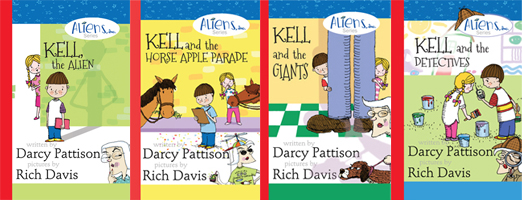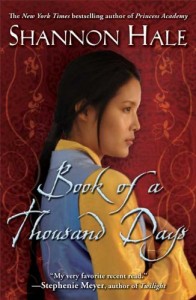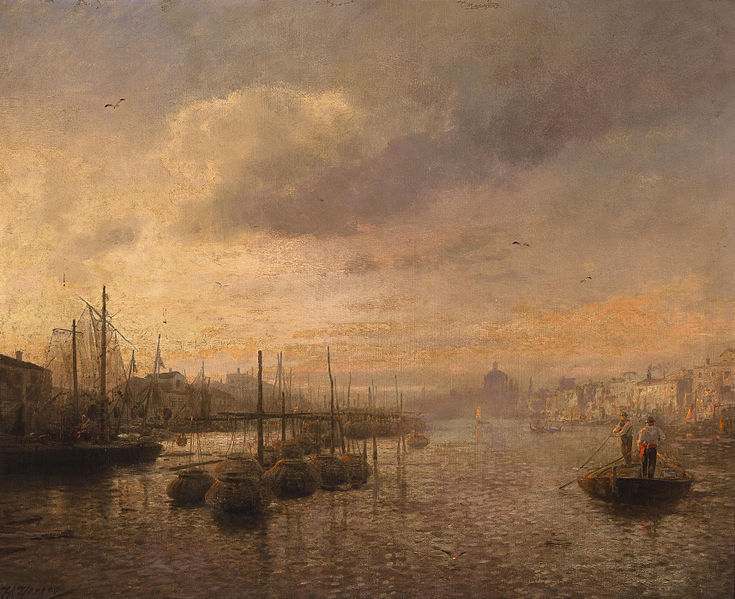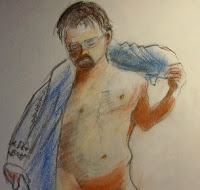new posts in all blogs
Viewing: Blog Posts Tagged with: metaphor, Most Recent at Top [Help]
Results 1 - 18 of 18
How to use this Page
You are viewing the most recent posts tagged with the words: metaphor in the JacketFlap blog reader. What is a tag? Think of a tag as a keyword or category label. Tags can both help you find posts on JacketFlap.com as well as provide an easy way for you to "remember" and classify posts for later recall. Try adding a tag yourself by clicking "Add a tag" below a post's header. Scroll down through the list of Recent Posts in the left column and click on a post title that sounds interesting. You can view all posts from a specific blog by clicking the Blog name in the right column, or you can click a 'More Posts from this Blog' link in any individual post.
Varian Johnson is the author of both middle grade and young adult novels, including THE GREAT GREEN HEIST, an ALA Notable Children's Selection.
Varian mentions that we often times don't even know we are using metaphor, it's ingrained into our psyche.
In writing, the tone of the metaphor must fit the style of the work. You can't use a metaphor that either the reader of the book or the character in the book couldn't understand. For example, a medieval character couldn't reference something contemporary.
Some rules for extended metaphor:
1. The metaphor should be established early.
2. The metaphor should build upon itself.
3. It should make sense in both tenor (the original idea of the metaphor) and vehicle (the borrowed idea of the metaphor).
4. It should carry through the entire piece.
Varian shared several examples of books that use extended metaphor.
In Marcus Zusak's GETTING THE GIRL, Zusak uses words to create an implied metaphor, comparing man to the sea, that he carries through the book.
In Laurie Halse Anderson's SPEAK, a tree metaphor is established and carried throughout. Varian also notes that nothing should be unintentional in a novel, including the names of the characters. The names in speak are a great example of this.
In EVERY TIME A RAINBOW DIES, Rita Williams Garcia uses a skirt to represent Ysa.
Advice: Don't feel so overwhelmed to get all the symbolism down in the first draft, even second and third.
Try Book 1 for Free

There’s an apocryphal story about a writer who worked hard all day. In the morning, he inserted a semi-colon; in the afternoon, he removed a semi-colon.
This morning, I inserted a metaphor; this afternoon, I removed the metaphor.
Metaphors continue to be a thorn in my side. I appreciate when I’m reading a story or novel and there’s an apt metaphor. It adds to my enjoyment because it expands the story and creates new connections. Such glimpses into the thought process of another human are one of the joys of reading.
Yet, when I sit down to write, I’m practically metaphor free. Partly, it’s because I find it tedious to sit down and add metaphors just because someone says my prose would improve with the use of metaphors. But as I’ve thought about it more, I’ve decided my problem is the difference in dominant vs. scattered imagery.

Dominant vs. Scattered Imagery
In their work of genius, How Does a Poem Mean, Miller Williams and John Ciardi discuss “The Image and the Poem” in Chapter 6. I refer you to their book for a full discussion of imagery, metaphors, similes and so on. For my purpose, though, let me concentrate on the question of dominant and scattered imagery. Here’s what Williams and Ciardi say:
“When the images of a given poem, or of a given passage, are related by their denotations, that poem or that passage is said to be constructed on a dominant image. When the images are related by their connotations but range widely in their denotations, that poem or passage is said to make use of scattered imagery.” (p. 247)
 Here are some imagery (metaphor/similie) from Shannon Hale’s Book of a Thousand Days
Here are some imagery (metaphor/similie) from Shannon Hale’s Book of a Thousand Days
- P. 1 I feel like a jewel in a treasure box. . .
- p. 2 Stay until your heart softens like long-boiled potatoes. . .
- p. 2 . . .skinny as a skinned hare.
- p. 8 It (the candle flame) tosses and bobs like a spring foal. . .
- p. 11 My heartache felt like a river, and I was sinking into it, carried away fast in its coldness.
- p. 12 . . if all they find is a delicate lady and her humble maid shriveled like ginger roots
- p. 13 I feel like a mucker from the ends of my hair to the mud of my bones.
- p. 13 It (lord’s house) was near as beautiful as a mountain in autumn. . .
- p 15 she sat on her bed, alone, straight as a tent pole
- p. 16. . . they resembled my own deel (clothing)as much as a worm resembles a snake.
- p. 18 . . . my lips thinner than the edge of a leaf.
- p. 18 He slapped his daughter’s face. . . like a snake striking.
- p. 20 She (Lady Saren) reminded me of a lamb just tumbled out, wet all over, unsure of her feet and suspicious of the sun.
Taken together, they don’t create a dominant image; Hale is using scattered imagery in a masterful way. Each image is directly related to the immediate situation. They don’t add up to a bigger image at the end—the collection of images don’t combine to create any symbolism.
Most of the time, when people mention the need for more metaphors in a piece, they mean this sort of scattered imagery.
However, when I write, I tend to write for a dominant image, using symbolism more than metaphors. The principle of selection of details for me is a wider scale. I’m looking for imagery that spreads across a whole chapter or even a whole novel.
Miller and Williams call this an overtone theme. (p. 110) They analyze the themes in a selection from John Milton’s Paradise Lost, concluding that Milton chose words and images based on two themes to describe the Biblical serpent who visited Eve: watery motion and regal splendor. A third category is when the two themes mesh.
Here’s a catalogue of the language:
- Watery Motion: indented wave, circular base, rising folds, fold upon fold, surging maze, floated redundant
- Regal splendor: carbuncled, burnished, gold, circling spires
- Combination of water and regal: towered, crested aloft
They say, “Whatever the value of such a tabulation, it cannot fail to make clear, first, that a unified principle of selection is at work in this diction, and second, that the words are being selected from inside their connotations and in answer to one another’s connotations, rather than from inside their denotation.”
Milton chose words/phrases because when they banged up against another word/phrase, they changed each other slightly. Circling spires weren’t just an architectural delight; instead, they hinted at regal splendor.
When I write, this is what I’m trying for: connotations speaking to connotations. I hope that I create a cumulative dominant image. I choose words based on certain themes and then work to make them collide.
Tips on Scattered Imagery
One reason I’m not fond of scattered imagery is that in the hands of a novice, it jerks me out of the current story. Here’s an example.
Setting: The principal tells you that you’ve won a scholarship, but to get it, you must accept an exchange student into your home for a year.
“. . . awesome news tossed into her lap like a grenade.”
Setting: A girl is thinking about a weird boy.
“ Thinking about him made her stomach hurt like she’d eaten a dozen McDonalds burgers at one sitting.”
These similes are easy to understand, contemporary, and not my favorite. In the first situation, a grenade carries the connotation of war, shock, and a shattered body. It’s too much for my taste because it pulls me out of a teen novel and instead, puts me in the Vietnam or Iraqi War.
In the second situation, I certainly understand that a dozen burgers (from anywhere) eaten in one sitting would give you a tummy ache. But how does this relate to the situation? It didn’t relate for me.
Hale sticks to imagery related to the immediate scene.
Setting: The princess and her maid are forced to become scullery maids in order to eat.
“Stay until your heart softens like long-boiled potatoes. . .”
In a kitchen setting, this makes sense. It also relates to the character who comes from the country and is familiar with the humble potato.
When you use scattered imagery, then, especially metaphors and similes, give them deep roots in the setting, not just a reference to a general cultural region.
And when you critique writing for others, remember the range of possibilities. Certainly, I always need to be challenged to use deeper imagery; but maybe, I don’t need to worry so much about just the one option for imagery called the metaphor.

“Metaphor lives a secret life all around us. We utter about six metaphors a minute. Metaphorical thinking is essential to how we understand ourselves and others, how we communicate and learn, discover and invent.” – James Geary
If you haven’t watched James Geary’s brilliant TED talk about metaphors, you should! Ten minutes might break open everything you think you know about this topic.


.png.jpg?picon=4257)
By: Diana Hurwitz,
on 9/12/2014
Blog:
Game On! Creating Character Conflict
(
Login to Add to MyJacketFlap)
JacketFlap tags:
fiction,
editing,
writing,
revision,
craft,
proofreading,
hyperbole,
metaphor,
oxymoron,
word use,
epizeuxis,
hypophora,
isocolon,
Litotes,
Add a tag
Here are more delicious rhetorical devices to add to your prose spice shelf.
Epizeuxis repeats a word in a sentence or clause for emphasis.
It was a long, long night for them both.
Hyperbole uses deliberate exaggeration. It can be funny or sarcastic. Use it sparingly.
Jane was so tired she could have slept for a year, maybe four.
Hypophora is similar to a rhetorical question, only the question is answered. Often the base clause or sentence poses the question and the modifying phrases answer it. In dialogue, it can be provocative if the character asks the question then answers it for the other person.
Jane turned to Dick. "So you want to slay the ghost, by yourself? No, no, I get it. You're strong; I'm weak. You're fast; I'm slow. I'd just get in your way. Fine, see if I care."
Isocolon stresses corresponding words, phrases, or clauses of equal length and similar structure.
Never had Dick promised so much, to appease so many, to benefit so few.
Litotes is an understatement that denies the opposite of the word the reader expects. It can use no or not. It creates confusion.
Jane was not a little angry with Dick for leaving her.
Metaphors can add richness and texture if used wisely. Metaphors compare two different things without using like or as in sentences and paragraphs. Not every simile is a metaphor, but every metaphor implies a simile. Dead metaphors and similes are often cliché, so it's important to cut them or change them up when possible. The biggest offender is the mixed metaphor in which the second proposition is inconsistent with the first.
Dick was able to shed some light on the text. (light = understanding)
Jane stared through the window at the black velvet sky. (sky = black velvet)
Oxymorons connect contradictory terms. You can find extensive lists on the internet. If you look for them, kill them whenever possible. They are hard to spot because they are so frequently used. Most readers won't recognize them as such.
A few examples include:
- act naturally
- active retirement
- almost exactly
- approximately equal
- blind eye
- born dead
- clearly confused
- controlled chaos
- deafening silence
- exact estimate
- found missing
- larger half
- old news
- open secret
- original copy
- seriously funny
- unbiased opinion
- virtual reality
Next week, we will contine adding spices to your prose shelf.
For the complete list of spices and other revision layers, pick up a copy of:

By: Sara Pinotti,
on 8/3/2014
Blog:
OUPblog
(
Login to Add to MyJacketFlap)
JacketFlap tags:
Books,
Philosophy,
Language,
comparisons,
venice,
Gerard Manley Hopkins,
metaphors,
Plato,
metaphor,
Rhetoric,
Humanities,
Editor's Picks,
*Featured,
ruskin’s,
john ruskin,
Rhetoric & Quotations,
critical imaginaiton,
james grant,
The Critical Imagination,
the stones of venice,
breezes,
ducal,
inexpressible,
Add a tag
By James Grant
Plato famously said that there is an ancient quarrel between philosophy and poetry. But with respect to one aspect of poetry, namely metaphor, many contemporary philosophers have made peace with the poets. In their view, we need metaphor. Without it, many truths would be inexpressible and unknowable. For example, we cannot describe feelings and sensations adequately without it. Take Gerard Manley Hopkins’s exceptionally powerful metaphor of despair:
selfwrung, selfstrung, sheathe- and shelterless,
thoughts against thoughts in groans grind.
How else could precisely this kind of mood be expressed? Describing how things appear to our senses is also thought to require metaphor, as when we speak of the silken sound of a harp, the warm colours of a Titian, and the bold or jolly flavour of a wine. Science advances by the use of metaphors – of the mind as a computer, of electricity as a current, or of the atom as a solar system. And metaphysical and religious truths are often thought to be inexpressible in literal language. Plato condemned poets for claiming to provide knowledge they did not have. But if these philosophers are right, there is at least one poetic use of language that is needed for the communication of many truths.
In my view, however, this is the wrong way to defend the value of metaphor. Comparisons may well be indispensable for communication in many situations. We convey the unfamiliar by likening it to the familiar. But many hold that it is specifically metaphor – and no other kind of comparison – that is indispensable. Metaphor tells us things the words ‘like’ or ‘as’ never could. If true, this would be fascinating. It would reveal the limits of what is expressible in literal language. But no one has come close to giving a good argument for it. And in any case, metaphor does not have to be an indispensable means to knowledge in order to be as valuable as we take it to be.
Metaphor may not tell us anything that couldn’t be expressed by other means. But good metaphors have many other effects on readers than making them grasp some bit of information, and these are often precisely the effects the metaphor-user wants to have. There is far more to the effective use of language than transmitting information. My particular interest is in how art critics use metaphor to help us appreciate paintings, architecture, music, and other artworks. There are many reasons why metaphor matters, but art criticism reveals two reasons of particular importance.

Take this passage from John Ruskin’s The Stones of Venice. Ruskin describes arriving in Venice by boat and seeing ‘the long ranges of columned palaces,—each with its black boat moored at the portal,—each with its image cast down, beneath its feet, upon that green pavement which every breeze broke into new fantasies of rich tessellation’, and observing how ‘the front of the Ducal palace, flushed with its sanguine veins, looks to the snowy dome of Our Lady of Salvation’.
One thing Ruskin’s metaphors do is describe the waters of Venice and the Ducal palace at an extraordinary level of specificity. There are many ways water looks when breezes blow across its surface. There are fewer ways it looks when breezes blow across its surface and make it look like something broken into many pieces. And there are still fewer ways it looks when breezes blow across its surface and make it look like something broken into pieces forming a rich mosaic with the colours of Venetian palaces and a greenish tint. Ruskin’s metaphor communicates that the waters of Venice look like that. The metaphor of the Ducal palace as ‘flushed with its sanguine veins’ likewise narrows the possible appearances considerably. Characterizing appearances very specifically is of particular use to art critics, as they often want to articulate the specific appearance an artwork presents.
A second thing metaphors like Ruskin’s do is cause readers to imagine seeing what he describes. We naturally tend to picture the palace or the water on hearing Ruskin’s metaphor. This function of metaphor has often been noted: George Orwell, for instance, writes that ‘a newly invented metaphor assists thought by evoking a visual image’.
Why do novel metaphors evoke images? Precisely because they are novel uses of words. To understand them, we cannot rely on our knowledge of the literal meanings of the words alone. We often have to employ imagination. To understand Ruskin’s metaphor, we try to imagine seeing water that looks like a broken mosaic. If we manage this, we know the kind of look that he is attributing to the water.
Imagining a thing is often needed to appreciate that thing. Knowing facts about it is often not enough by itself. Accurately imagining Hopkins’s despondency, or the experience of arriving in Venice by boat, gives us some appreciation of these experiences. By enabling us to imagine accurately and specifically, metaphor is exceptionally well suited to enhancing our appreciation of what it describes.
James Grant is a Tutorial Fellow in Philosophy at Exeter College, Oxford. He is the author of The Critical Imagination.
Subscribe to the OUPblog via
email or
RSS.
Subscribe to only philosophy articles on the OUPblog via
email or
RSS.
The post Why metaphor matters appeared first on OUPblog.

 The Writer's Chronicle for May/Summer 2012 includes an article by David Jauss with the slightly hokey title of "Who's Afraid of the Big Bad Abstraction?: Modes of Conveying Emotion." Nonetheless, as with most essays and articles by Jauss on the craft of writing, it helps identify strategies for mustering life into faltering prose.
The Writer's Chronicle for May/Summer 2012 includes an article by David Jauss with the slightly hokey title of "Who's Afraid of the Big Bad Abstraction?: Modes of Conveying Emotion." Nonetheless, as with most essays and articles by Jauss on the craft of writing, it helps identify strategies for mustering life into faltering prose.
Jauss is keen to make the point that emotions reside in the senses, and "without some appeal to the senses, ... it is very difficult, if not downright impossible, for us to make our readers experience our character's emotions." He suggests the "primary ways writers can convey emotion through the senses are body language and metaphors." But it can be hard work to convey such emotion on the page, and often the writer will take a shortcut, i.e. just use an abstraction, a sensory bypass, and get on with the story. For instance:
Cornell experienced an immense grief.
But when we abstract like this, Jauss cautions, "we are asking the reader to do the hard work of imagining the physical sensations of the emotion for us, and the readers aren't any less susceptible to laziness than we are ...so she just skips the trip entirely." And maybe also closes the book. Jauss gives his own examples where, instead of simply naming the character's emotion, as in the sensory bypass naming Cornell's grief, a writer might work a little harder at portraying the emotion in some unexpected way. "In A Gate at the Stairs, Lorrie Moore makes Bo Keltjin's grief visible through his unusual use of a handkerchief at his son's funeral. Instead of drying his eyes with it, as we might expect, he 'presse[s] it completely over his face, like a barber's hot towel.' With a sentence like that, we don't need the word grief; we witness it."
And then we have the gloss. "Whereas a sensory bypass might allude to body language but doesn't actually describe it, a gloss does describe body language--but then proceeds to interpret it for the reader. As in:
Tears of grief wet Cornell's face.
The writer is trying to make sure the reader hasn't missed a turn somewhere and is interpreting those tears correctly.
Another interesting area of enriching sensory language to rescue it from mere gloss or abstraction as discussed by Jauss is to mix the body language with metaphor. To illustrate, he takes another example from Lorrie Moore: "'Here Sarah looked at me mischievously, her look a complicated room one might wander through, exploring for quite some time if there were any time.' If Moore had merely said, 'Here Sarah looked at me mischievously,' she would have been guilty of writing a gloss and the emotion labeled by the abstract evaluation mischievously would have been dead on arrival. The metaphor brings it to life."
Jauss gives many more juxtapositions of body language, abstraction, gloss, metaphor, and action that can bring emotional life to your characters, and the complete article is worth reading.

By:
Darcy Pattison,
on 3/10/2009
Blog:
Darcy Pattison's Revision Notes
(
Login to Add to MyJacketFlap)
JacketFlap tags:
writing life,
clouds,
craft,
sky,
Metaphor,
be a writer,
descriptions,
John Constable,
story,
weather,
character,
Add a tag
Craft Challenges for the Writing Life
Whatever you write - novels, poetry, picture books, nonfiction - it’s important to keep your craft growing and improving. I take this seriously and find ways to challenge myself.
One way has been the Friday Ideas group, which has kept me searching for viable picture book ideas.
This year, I’m taking the Sky Challenge.

(click to enlarge)
When I went to New York City for the SCBWI Mid-Winter conference, one day, I visited the JP Morgan Library, where they had an exhibit of landscape paintings. One was a painting of sky by John Constable. The label beside it said that Constable had spent a year studying sky and clouds, so he could improve his landscapes.
So, I decided to take Constable’s Sky Challenge and write something about the sky every day. Study the sky, find ways to describe it, without repeating or being boring. After a month, here are some things I’ve learned.
- It’s fun. Focusing my attention on something like the sky has been fun. It is, of course, always changing, so there’s always something to notice, a habit that writers should always cultivate.
- It’s challenging. OK, how many ways can you write blue? Or grey clouds? I’m finding that the verbs are very important; but that comes with challenges, too, because how many times can you write that the wind sculpted the clouds? The wind becomes a major character in this challenge and it’s hard to find another agent of action. Hard, but I’m finding hints here and there.
- I’m better at metaphors than I thought. I don’t use many metaphors in my writing, but I’m finding that I watch the sky, then mull over what I’ve seen and try to think of some fresh way to describe it. Again, how many times can you write that yellow light spread over the grey clouds?
- Examples:
Torn clouds blew across the wind-chapped face of the sky.
Someone had poured melted butter over the grey clouds.
Wisps of clouds were frayed by the last sigh of winter giving way to spring.
Join me! Take the sky challenge. Even if you only do it for a month, instead of a year! I think it will help me to portray how weather affects a character in a story.
Post from: Revision Notes
Revise Your Novel!
Copyright 2009. Darcy Pattison. All Rights Reserved.
Related posts:
- Originality
- Friday Ideas 2008
- Starting a Novel with Voice

I've noticed several people linking to the series now that it's over, and to facilitate this, here is a link post.
Introduction
The Two DS9s - Did Deep Space Nine only get good in its later seasons?
The Menagerie - Alien races on the show
Looking for Ron Moore in All the Wrong Places - The obligatory Battlestar Galactica comparison
What Does God Need With a Space Station? - Deep Space Nine's
Believe it or not, after seven installments there's still stuff left to say about Deep Space Nine. Here are a few topics that didn't grow into full-fledged essays:
It's an axiom of television writing that romance, and specifically romantic pursuit, is interesting, but established relationships, and most especially marriages, are boring. Perhaps because it was generally strongest when telling
BENDER: Forget it, you can't tempt me.
ROBOT DEVIL: Really? There's nothing you want?
BENDER: Hm. I forgot you could tempt me with things I want.
Futurama, "The Devil's Hands Are Idle Playthings"If Deep Space Nine's character development has a theme, it is the loss of innocence, and of an idealized self-image. The characters who undergo this process most prominently over the course of the
The breathtaking awesomeness of Kira Nerys, which has been recurring theme in these essays, became apparent to me only a few episodes into my journey back through Deep Space Nine. Almost as soon as I came to this realization, I started pondering a question: how is that this fantastic character, who is strong, capable, confident, and decent, doesn't have pride of place in the pantheon of kickass
No one who watched Deep Space Nine's pilot episode, "Emissary," would have had any reason to expect a subtle, multi-faceted treatment of religion from the series. Though by no means disrespectful or dismissive of religion, "Emissary" treats it in a manner familiar from many other genre stories--the SFnal trope of alien (or human) gods who turn out to be aliens themselves, the fantasy standard of
It's impossible to come back to Deep Space Nine in 2007 and not be on the lookout for Ronald D. Moore, for his influence on the series and its influence on his later work. Deep Space Nine is where Moore made his bones, rising from staff writer to executive producer. It is also, of all the series he's been involved with, the one closest in topic, tone, and theme to Battlestar Galactica. Just in
A work of fiction passes Alison Bechdel's Dykes to Watch Out For test if it features two women having a conversation about something other than a man. Deep Space Nine passes the Bechdel test, but not before it passes, several times over, its SFnal corollary by featuring two aliens having a conversation about something other than a human, the Federation, or Starfleet.
Deep Space Nine, as I've
It is a truth universally acknowledged that the first three seasons of Deep Space Nine sucked.
OK, so that's an overstatement. But there is a consensus among the show's fans that its early seasons were missing a certain component, and that Deep Space Nine didn't come into its own and earn the title of best Star Trek series until its fourth season, and until the addition of Worf, the Defiant,
Once again, this is my brother's doing. He's the one who, in the spring, suggested a return to yet another staple of our youthful TV watching, Star Trek: Deep Space Nine. And it's partly the fault of the WGA, too. It's because of their still-ongoing strike that I had no new TV to watch, and so the last weeks of 2007 became dedicated to making my way through all seven seasons and 176 episodes














Loved this! Thank so much for sharing.